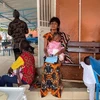HCM City (VNA) – Ho Chi Minh City recorded an average prenatal and newborn screening rate at over 80 percent on an annual basis since 2011, heard a meeting celebrating Vietnam's Population Day (Dec. 26) held in the city on December 20.
According to statistics from the municipal Department for Population Family Planning, between 2011 and September this year, 247,900 local women received prenatal screening, of whom 14,000 were diagnosed with diseases, while the figures for infants stood at 233,400 and 970. The screening tests facilitated early treatments, which helped reduce the rate of newborns with disabilities.
Nguyen Huu Hung, Deputy Director of the municipal Health Department, said a large number of residents are unaware of these benefits, thus creating difficulties for communications work.
He also attributed low number of participants in various prenatal and newborn screening tests to the fact that only two types of which are currently subsided by the State.
Speaking at the ceremony, Nguyen Van Tan, deputy head of the General Office for Population and Family Planning, lauded efforts made by the municipal authorities in making prenatal and newborn screening available to residents.
He suggested the city review its policy for birth rate reduction, as the local replacement birth rate is at the lowest level nationwide, hovering around 1.3 - 1.4 children per woman.
He asked the city to work out specific plans of action to carry out the Party Central Committee’s Resolution 21 on population work, toward the goals of sustaining the replacement fertility rate, bringing the sex ratio at birth down to the suitable level, fully tapping the gold population structure, and adapting to the aging population.-VNA
According to statistics from the municipal Department for Population Family Planning, between 2011 and September this year, 247,900 local women received prenatal screening, of whom 14,000 were diagnosed with diseases, while the figures for infants stood at 233,400 and 970. The screening tests facilitated early treatments, which helped reduce the rate of newborns with disabilities.
Nguyen Huu Hung, Deputy Director of the municipal Health Department, said a large number of residents are unaware of these benefits, thus creating difficulties for communications work.
He also attributed low number of participants in various prenatal and newborn screening tests to the fact that only two types of which are currently subsided by the State.
Speaking at the ceremony, Nguyen Van Tan, deputy head of the General Office for Population and Family Planning, lauded efforts made by the municipal authorities in making prenatal and newborn screening available to residents.
He suggested the city review its policy for birth rate reduction, as the local replacement birth rate is at the lowest level nationwide, hovering around 1.3 - 1.4 children per woman.
He asked the city to work out specific plans of action to carry out the Party Central Committee’s Resolution 21 on population work, toward the goals of sustaining the replacement fertility rate, bringing the sex ratio at birth down to the suitable level, fully tapping the gold population structure, and adapting to the aging population.-VNA
VNA























